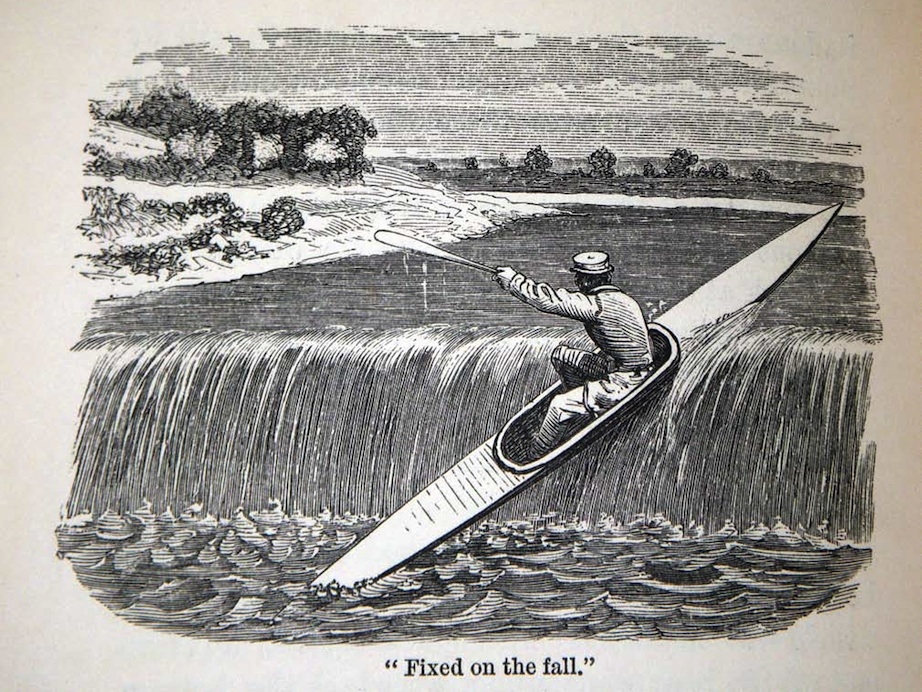Okay, it’s not War and Peace, or even an early edition of How to Shit in the Woods, but it’s noteworthy when a little-known volume called The Rob Roy on the Baltic by John MacGregor, first published in 1866, is being re-published in 2009.
MacGregor revolutionized waterborne travel in Europe by turning around to face forward in what was essentially a rowing scull. Instead of rowing with oars he opted to alternate dips with a double-bladed paddle. His dream was to tour the Baltic and also paddle through Europe passing out religious tracts (but that’s another story) on water- ways possibly too small for a conventional rowboat. About the decision to “canoe” in- stead of row across Europe, he wrote:
“It was clear no rowboat would serve on a voyage of this sort, for in the wildest parts of the best rivers the channel is too narrow for oars, or, if wide enough, it is often too shallow; and the tortuous passages…that constantly occur on a river winding among hills, make those very parts where the scenery is wildest and best to be quite unapproachable in such a boat, for it would be swamped by the sharp waves, or upset over the sunk- en rocks, which cannot be seen by a steersman [facing the stern].”
MacGregor named his 15-foot decked canoe for his famous ancestor Rob Roy and when he returned from his odyssey in 1865 he wrote the best-selling A Thousand Miles in the Rob Roy Canoe. In it, he celebrated paddling just for the sake of paddling, which was then a novel idea. Building on the book’s success, he founded the Royal Canoe Club and the idea crossed the Atlantic.
And so began the sport of recreational canoeing, say some. Recreational canoeing in Canada inspired by a Brit? Maybe, in part. For more on the story we need to look into an exhibit at The Canadian Canoe Museum in Peterbrough, Ontario.
Its name is Harmony and it’s a lightweight decked canoe very similar to MacGregor’s. One might assume Harmony is derivative of Rob Roy, after all, the two were built only 10 kilometres from each other. But that gets turned upside down by research which suggests that Harmony was built before John MacGregor cooked up his design and paddled off to become famous.
In piecing the story together it seems that Dr. George Mellis Douglas purchased Harmony when passing through London and had the craft shipped home for his son Campbell. According to Douglas, writing in Forest and Stream in 1886:
“This canoe was built [before] Mr. MacGregor brought canoeing into notice by the publication of his well known cruise in the Rob Roy… On the eve of my departure for India in 1865, I had her sent out to Quebec… Last year I remembered my old canoe and had her sent to me at Lakefield, where she was renovated and again put in com- mission this spring. The Harmony is a paddling canoe, pur et simple [sic].” In the fullness of time, the son Campbell had a son—another George Mellis Douglas—who was one of the first Barren Land explorers to extensively photograph the Northwest Territories in the early 20th century. He lived out his days paddling Harmony, much in the spirit of MacGregor, on Lake Katchewanooka, not far from Harmony’s current home in the museum.
Was there a relationship between George Mellis Douglas, the elder, and John MacGregor? Did MacGregor model his boat after Harmony? Is Harmony the canoe that started it all? Questions. Lots of questions. A Thousand Miles in the Rob Roy Canoe (readable at www.ibiblio.org) or Rob Roy on the Baltic (re-released by Dixon-Price) are excellent places to start looking for answers
This article appeared in Canoeroots & Family Camping, Late Summer 2011.




